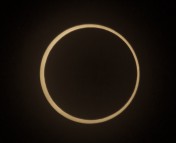Title: Computer analysis of some ancient Chinese sunrise eclipse records to determine the Earth’s rotation rate
Authors: Kevin D. Pang, Kevin Yau, Hung-hsiang Chou, Robert Wolff
First Author’s Institution: Jet Propulsion Lab., Caltech, USA
Status: Published in Vistas in Astronomy [closed access]
Total solar eclipses have dazzled humanity for as long as we’ve existed. Today, eclipses provide a unique opportunity to do science, like studying the Sun and how it affects the Earth. In the past, even long before we understood how eclipses happen, astronomers were observing and attempting to time them – creating records that are incredibly useful to us today. Today’s paper, published in 1988, is a part of a body of work in which modern day astronomers used records of eclipses from their ancient counterparts to determine the history of Earth’s slowing rotation.
Solar Eclipses & Earth’s Rotation
We now know that the Earth’s rotation is gradually slowing mainly due to tidal interactions with the Moon. (In fact, the first person to realize that Earth’s rotation must have changed was Sir Edmond Halley when he noticed that the locations of solar eclipses in historical texts were thousands of miles away from his calculations when he ran the clock back!) However, the rotation rate is also affected by non-tidal phenomena like core-mantle interactions, sea level changes, and the melting of polar ice caps, making it tricky to track Earth’s rotation variation over time.
Here’s where records of ancient eclipses can help: Each record includes the approximate date, time, and location of an eclipse. Eclipses occur when the Sun, Moon, and Earth are perfectly aligned, and the motions of these bodies are well understood, so the date and time of an eclipse record can be used to compare it to a computational model. Then, the Earth’s rotation rate is adjusted within the model until the path of totality crosses the location where the eclipse was observed. And voila! The model has calculated the Earth’s rotation rate at the time of the eclipse relative to present day. Repeat this process for eclipse records spanning thousands of years, and you end up with a detailed description of Earth’s rotation history.
Ancient Chinese Eclipse Records
This paper uses ancient Chinese eclipse records, though other works have produced similar results using Babylonian and Arabian records. At the time of this paper’s publication, around 150,000 Chinese astronomical texts spanning over 4000 years had been analyzed and compiled. These records are remarkably reliable, credited in part to the fact that astronomical events were useful guides for timekeeping and thus early Chinese astronomers were diligent observers.
Despite their accuracy, most records don’t include the precise time of day that the eclipse occurred. To mitigate this, the authors only used solar eclipses that occurred during sunrise, essentially eliminating time of day as a variable because the sunrise time could be calculated from the date and location within their model. Other historical discrepancies also had to be considered. For example, a record from 532 CE had nearly identical wording to one from 529 CE, during a time when China was divided into the North and South Dynasties, resulting in dubious records. By comparison to their eclipse models, the authors determined the 532 CE record was correct, and that the other was later duplicated in error.
The Double Dawn Eclipse
One record we’re particularly lucky to have is of an eclipse that occurred in 899 BCE, called the “double dawn” eclipse. It comes from a book called the Bamboo Annals, which is one of only a few texts written during the Eastern Zhou Dynasty to survive the burning of books by the First Emperor of China. The Bamboo Annals had previously been buried in the tomb of King Hsiang in the 3rd century BCE, and survived the plights of grave robbers who took precious objects and burned books to light their way. Fortunately, the Bamboo Annals were left behind.
The record states “During the 1st year of King Yi [of Western Zhou] the day dawned twice at [a place called] Zheng”. The authors interpreted “the day dawned twice” to mean that eclipse totality occurred as the Sun was rising, such that the sky began to brighten, was plunged into darkness, then brightened again, as demonstrated in Figure 1.

Analysis of eclipses that both occurred around the time King Yi is believed to have begun his reign and could have coincided with the sunrise in Zheng found that this event was likely an annular eclipse that happened on April 21, 899 BCE. From the best-fitting model for this eclipse, they determined that Earth’s rotation slowed by 5 hours and 48 minutes from 899 BCE to 1800 CE. A little more intuitively, this means that a day is approximately 50 milliseconds longer now than it was 3000 years ago. The calculations for the other eclipses they examined are shown in Figure 2.

The results are consistent with those of previous works using Babylonian and Arabian eclipses, as well as more modern works. Thanks to similar calculations spanning eclipses throughout history, and the faithful observations made by astronomers of the past, we now have a much better understanding of the history of our planet’s rotation. Solar eclipses are not only stunning, but were also the serendipitous link in this collaboration across millennia.
Astrobite edited by Lucas Brown
Featured image credit: The Metropolitan Museum of Art, New York, Gift of Robert E. Tod, 1929 www.metmuseum.org




